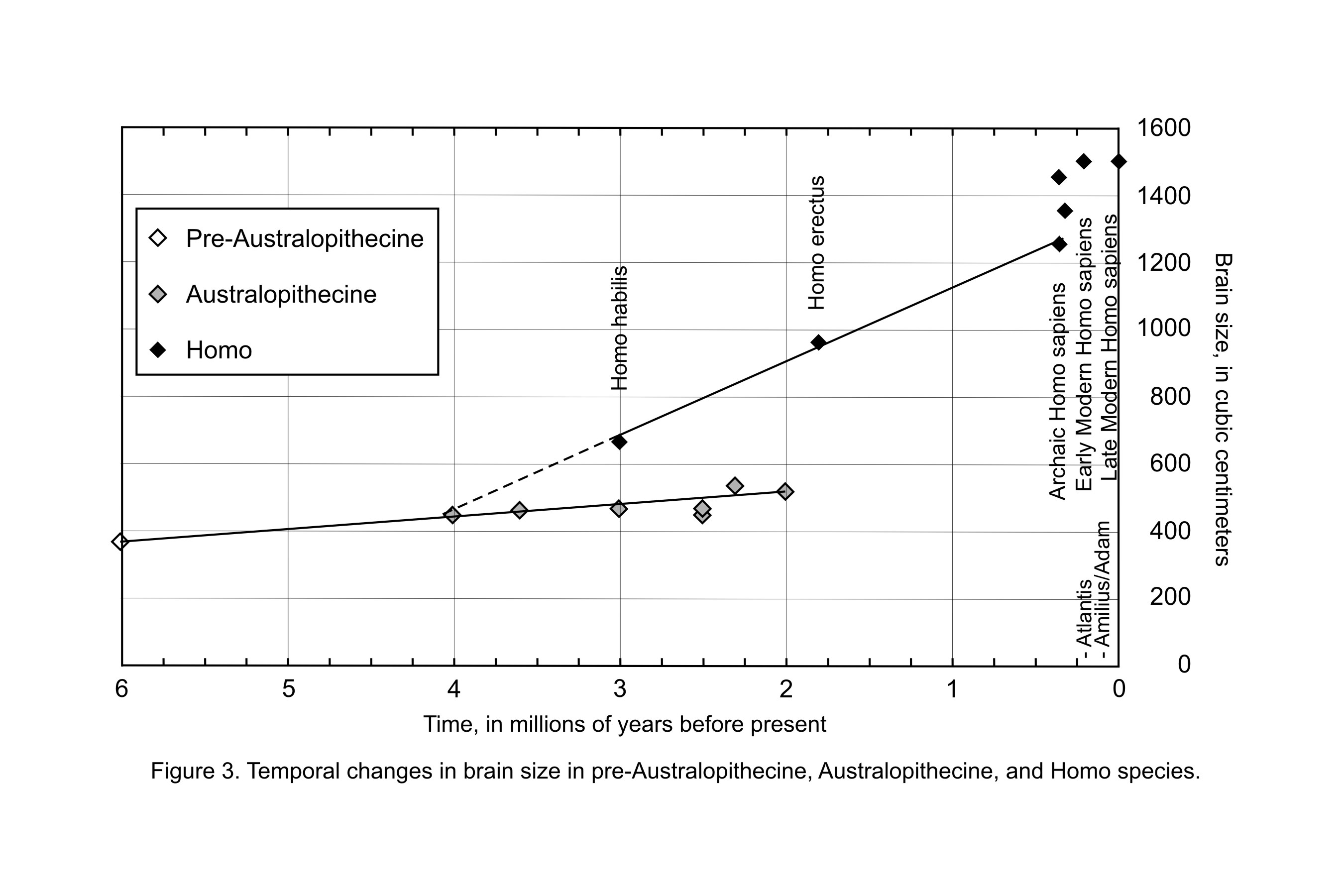
Temporal Changes in Brain Size in Australopithecine and Homo species
The Hominini tribe consists of chimpanzees and human species that separated from their common ancestor about seven to ten million years ago. The human line proceeded to evolve through a series of body forms called pre-Australopithecines and Australopithecines until about three million years ago when the first genus Homo species appeared on the scene. The pre-Australopithecines and Australopithecines were humanlike animals or animallike humans that retained apelike features, including a tilted face with a protruding jaw and low forehead. They had the small brain and prominent brow ridges that were characteristic of their chimpanzee relatives, but they were bipedal (they walked upright on two legs), and had developed a non-honing denture arrangement that became characteristic of their human descendants. The first two characteristics are apelike, and the last two are humanlike. One pre-Australopithecines species that lived from about 5.6 Mya to 4.4 Mya did not have a grasping toe, which indicates the beginning of a transition from tree dweller to tree-ground dweller to pure ground dweller. The evolution of pre-Australopithecines and Australopithecines species was accompanied by a modest increase in brain size from about 350 cubic centimeters to about 450+ cubic centimeters but the members of neither species could speak because they had not developed a hyoid bone, the small bone in the neck that is necessary for speech in humans.
About three to four million years ago the appearance and intelligence of the genus Homo predecessors began to change. With the arrival of Homo habilis and their successors Homo erectus there are indications of a flatter face and more well-developed bipedal locomotion on short legs. More importantly, fossil evidence indicates the development of larger bodies and a substantial increase in brain size, and excavations of their habitation sites show that they could use stone tools and control fire. By about 300,000 years ago human ancestors had evolved into Homo sapiens who had flatter faces; higher, more vertical foreheads; rounded and taller skulls, and projecting chins. These species include the Neanderthals which retained some of facial characteristics of their ancestors but had a brain size of 1,500 cubic centimeters, as large as modern man. The Neanderthals practiced the burying of their dead and likely had the ability to speak, as is indicated by the presence of fossil hyoid bones in Neanderthal remains. They were extinct and had been superseded by modern Homo sapiens by about 30,000 years ago. Neanderthal DNA is still mixed with modern human DNA in European and Asian populations at about one to four percent, testifying to the interbreeding of these species.
Here is where archeology meets the Edgar Cayce readings and things become interesting. What was the cause of the remarkably abrupt rise in human brain size in such a short span of evolutionary time? Why did modern Homo sapiens, the only human species that exists today, flourish while similar related species, the Neanderthal and their relatives, dwindle and perish? Were souls intruding into ancestral human body forms that were similar to ours today? The readings suggest that the accelerated rate of human brain development was in some way related to the increasing interference of souls in the Homo genus human forms that developed on the earth through evolutionary processes. It was always God's intention for souls to use the earth environment as a rehabilitation center, but did they jump the gun before God was ready for them? The readings say that is precisely what happened. Once again, soul rebellion upsets the good order of creation. Because the chaotic situation was not conducive to God's plan to use the earth as a place where souls could learn to apply spiritual principles that would to lead to soul evolution, God created a better vehicle for soul incarnation. That creation, a refined human body based the existing human forms, is described symbolically in the Bible as the creation of Adam and in the readings as the entry into the earth environment of the soul Amilius about 106,000 years ago. The new body form would eventually supersede the older evolved forms and souls would only incarnate into the new Adamic body form. The mission of Amilius was and is to save souls from their tendency to rebel against God through selfish activity by teaching soul-inhabited humans to love and trust God unconditionally, and to love their neighbors as themselves. Ultimately, souls must become aware that they are portions of God and become fully conscious of their oneness with God to return to companionship with God.